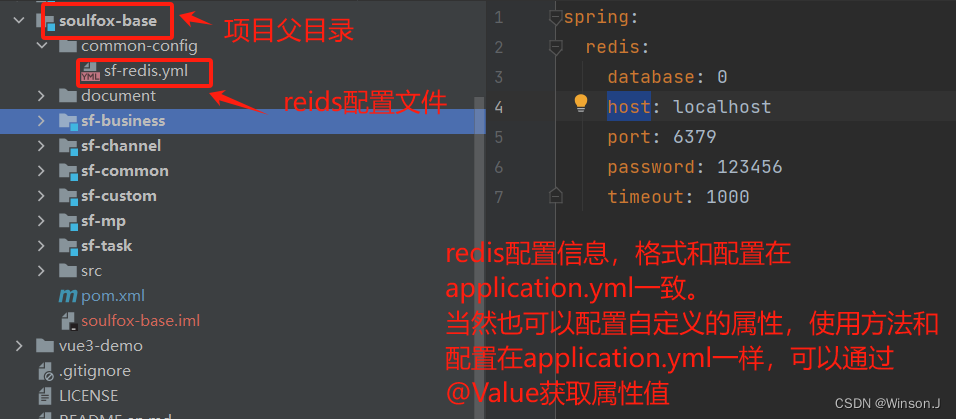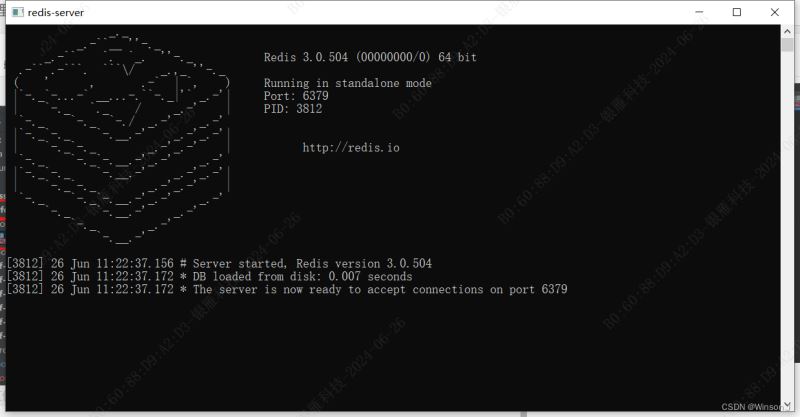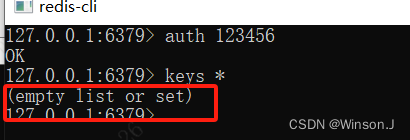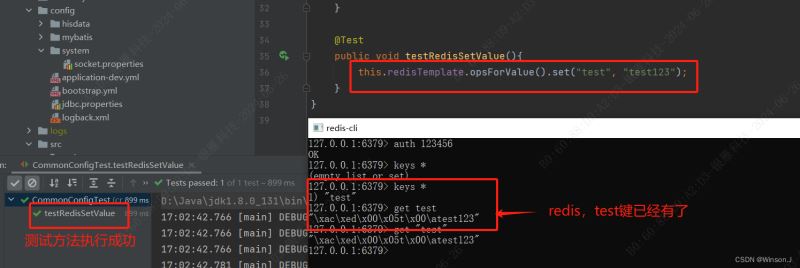背景
公司产品微服务架构下有十几个模块,几乎大部分模块都要连接redis。每次在客户那里部署应用,都要改十几遍配置,太痛苦了。当然可以用nacos配置中心的功能,配置公共参数。不过我是喜欢在应用级别上解决问题,因为并不是每个项目都会使用nacos,做个知识储备还是不错的。
公共配置文件位置

启动本地redis(windows版)

当前redis 没有数据

初始化redis
这里的初始化和正常把redis配置信息放到application.yml里的初始化是一样的。
package cn.com.soulfox.common.config;
import lombok.extern.slf4j.slf4j;
import org.springframework.boot.autoconfigure.condition.conditionalonclass;
import org.springframework.boot.autoconfigure.condition.conditionalonmissingbean;
import org.springframework.boot.autoconfigure.data.redis.redisproperties;
import org.springframework.boot.context.properties.enableconfigurationproperties;
import org.springframework.context.annotation.bean;
import org.springframework.context.annotation.configuration;
import org.springframework.data.redis.connection.redisconnectionfactory;
import org.springframework.data.redis.core.redisoperations;
import org.springframework.data.redis.core.redistemplate;
import org.springframework.data.redis.serializer.jdkserializationredisserializer;
import org.springframework.data.redis.serializer.stringredisserializer;
/**
*
* @create 2024/4/11 10:48
*/
@configuration
@conditionalonclass(redisoperations.class)
@enableconfigurationproperties(redisproperties.class)
@slf4j
public class redistemplateconfig {
@bean
@conditionalonmissingbean(name = "redistemplate")
public redistemplate<string, object> getredistemplate(redisconnectionfactory factory){
log.info("开始初始化 redistemplate ------------------");
redistemplate<string, object> redistemplate = new redistemplate<>();
// key的序列化类型
redistemplate.setkeyserializer(new stringredisserializer());
redistemplate.sethashkeyserializer(new stringredisserializer());
redistemplate.sethashvalueserializer(new jdkserializationredisserializer());
redistemplate.setvalueserializer(new jdkserializationredisserializer());
redistemplate.setconnectionfactory(factory);
log.info("初始化 redistemplate 结束------------------");
return redistemplate;
}
}
解析自定义sf-redis.yml
package cn.com.soulfox.business.config;
import org.springframework.beans.factory.config.yamlpropertiesfactorybean;
import org.springframework.context.annotation.bean;
import org.springframework.context.annotation.configuration;
import org.springframework.context.support.propertysourcesplaceholderconfigurer;
import org.springframework.core.io.filesystemresource;
import org.springframework.stereotype.component;
/**
*
* @create 2024/6/26 16:41
*/
@configuration
public class commonconfig {
@bean("common-config")
public static propertysourcesplaceholderconfigurer properties() {
propertysourcesplaceholderconfigurer configurer = new propertysourcesplaceholderconfigurer();
yamlpropertiesfactorybean redis = new yamlpropertiesfactorybean();
//文件路径写死的,真正做项目时,文件路径可以配置到application.yml文件
filesystemresource redisresource = new filesystemresource("../common-config/sf-redis.yml");
redis.setresources(redisresource);
configurer.setpropertiesarray(redis.getobject());
//如果有多个配置文件,也是可以处理的。setpropertiesarray(properties... propertiesarray)方法的参数是个数组,
//如下还可以同时处理文件sf-ports.yml,此时configurer.setpropertiesarray(redis.getobject());代码要注释掉
//yamlpropertiesfactorybean ports = new yamlpropertiesfactorybean();
// filesystemresource portsresource = new filesystemresource("../common-config/sf-ports.yml");
// ports.setresources(portsresource);
//同时添加sf-redis.yml和sf-ports.yml的配置信息
// configurer.setpropertiesarray(redis.getobject(), ports.getobject());
return configurer;
}
}
应用启动类
注意一下,因为我已经搭建了完整的微服务,包括nacos,mybatis,feign等,所有启动类上注解比较多。如果只是单纯测试一下,引入springboot基础框架和redis依赖,写一个基础启动类就可以了。
package cn.com.soulfox.business;
import org.springframework.beans.factory.config.yamlpropertiesfactorybean;
import org.springframework.boot.springapplication;
import org.springframework.boot.autoconfigure.springbootapplication;
import org.springframework.cloud.client.discovery.enablediscoveryclient;
import org.springframework.cloud.openfeign.enablefeignclients;
import org.springframework.context.annotation.bean;
import org.springframework.context.annotation.componentscan;
import org.springframework.context.support.propertysourcesplaceholderconfigurer;
import org.springframework.core.io.filesystemresource;
import org.springframework.core.io.pathresource;
import org.springframework.core.io.resource;
import org.springframework.transaction.annotation.enabletransactionmanagement;
import tk.mybatis.spring.annotation.mapperscan;
import java.io.file;
@springbootapplication
@enablediscoveryclient//nacos注册中心
@enablefeignclients(basepackages = {"cn.com.soulfox.common.feign.client"})//feign扫描
@mapperscan(basepackages={"cn.com.soulfox.*.mvc.mapper"})//mybatis mapper扫描
@enabletransactionmanagement//开启数据库事务
@componentscan("cn.com.soulfox")
public class businessapplicationrun {
public static void main(string[] args) {
springapplication.run(businessapplicationrun.class, args);
}
}
启动一下应用看看redis是否初始化成功

测试一下是否可以正常使用
单元测试类
package cn.com.soulfox.common.config;
import cn.com.soulfox.business.businessapplicationrun;
import org.junit.test;
import org.junit.runner.runwith;
import org.springframework.beans.factory.annotation.autowired;
import org.springframework.beans.factory.annotation.value;
import org.springframework.boot.test.context.springboottest;
import org.springframework.data.redis.core.redistemplate;
import org.springframework.test.context.junit4.springrunner;
/**
*
* @create 2024/6/26 16:52
*/
@runwith(springrunner.class)
@springboottest(classes = businessapplicationrun.class,
webenvironment = springboottest.webenvironment.random_port)
public class commonconfigtest {
@autowired
private redistemplate<string, object> redistemplate;
//文件sf-redis.yml里属性的使用和applications.yml一样
@value("${spring.redis.host}")
private string redishost;
@test
public void test(){
system.out.println("从文件取参数测试+++++++++++");
system.out.println("redishost: " + redishost);
}
}
测试sf-redis.yml属性使用
使用方法和配置在application.yml文件是一样,都是通过@value注解获取
测试结果

测试redis是否可以正常使用
测试写入数据,增加以下测试方法
@test
public void testredissetvalue(){
this.redistemplate.opsforvalue().set("test", "test123");
}
测试结果

测试读取数据,增加以下测试方法
@test
public void testredisgetvalue(){
object testvalue = this.redistemplate.opsforvalue().get("test");
system.out.println(testvalue);
}
测试结果

总结一下
现在的微服务,大多使用nacos作为注册中心,同事nacos也能作为配置中心使用。公共配置一般放在nacos中,以上方法没有什么用处。但总有项目可能不会使用nacos,比如使用eureka,这时候以上方法就有用武之地。这个方法可以作为知识储备,了解一下总是有好处的 :–)
还有一点需要注意的,就是yml文件是在程序启动后解析的,所以文件里的配置信息,在application.yml里是不能通过${xxx.xxx}使用的。
以上就是springboot解析自定义yml文件的流程步骤的详细内容,更多关于springboot解析yml文件的资料请关注代码网其它相关文章!






发表评论